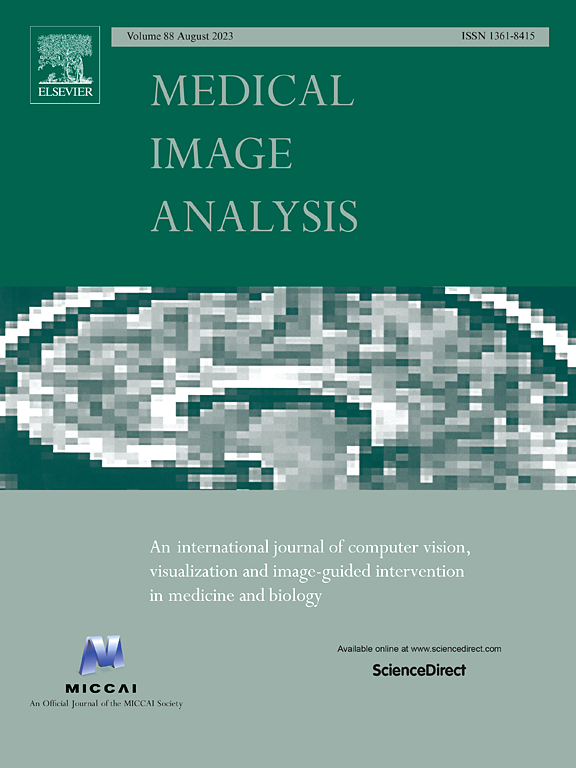Segment Any Tissue: One-shot reference guided training-free automatic point prompting for medical image segmentation
IF 11.8
1区 医学
Q1 COMPUTER SCIENCE, ARTIFICIAL INTELLIGENCE
引用次数: 0
Abstract
Medical image segmentation frequently encounters high annotation costs and challenges in task adaptation. While visual foundation models have shown promise in natural image segmentation, automatically generating high-quality prompts for class-agnostic segmentation of medical images remains a significant practical challenge. To address these challenges, we present Segment Any Tissue (SAT), an innovative, training-free framework designed to automatically prompt the class-agnostic visual foundation model for the segmentation of medical images with only a one-shot reference. SAT leverages the robust feature-matching capabilities of a pretrained foundation model to construct distance metrics in the feature space. By integrating these with distance metrics in the physical space, SAT establishes a dual-space cyclic prompt engineering approach for automatic prompt generation, optimization, and evaluation. Subsequently, SAT utilizes a class-agnostic foundation segmentation model with the generated prompt scheme to obtain segmentation results. Additionally, we extend the one-shot framework by incorporating multiple reference images to construct an ensemble SAT, further enhancing segmentation performance. SAT has been validated on six public and private medical segmentation tasks, capturing both macroscopic and microscopic perspectives across multiple dimensions. In the ablation experiments, automatic prompt selection enabled SAT to effectively handle tissues of various sizes, while also validating the effectiveness of each component. The comparative experiments show that SAT is comparable to, or even exceeds, some fully supervised methods. It also demonstrates superior performance compared to existing one-shot methods. In summary, SAT requires only a single pixel-level annotated reference image to perform tissue segmentation across various medical images in a training-free manner. This not only significantly reduces the annotation costs of applying foundational models to the medical field but also enhances task transferability, providing a foundation for the clinical application of intelligent medicine. Our source code is available at https://github.com/SnowRain510/Segment-Any-Tissue.
分割任意组织:用于医学图像分割的一次性参考引导无训练自动点提示
医学图像分割经常遇到标注成本高、任务自适应困难的问题。虽然视觉基础模型在自然图像分割中显示出前景,但自动生成高质量的提示信息用于医学图像的类别无关分割仍然是一个重大的实际挑战。为了解决这些挑战,我们提出了一种创新的、无需训练的框架,旨在自动提示分类无关的视觉基础模型,用于仅使用一次参考对医学图像进行分割。SAT利用预训练基础模型的强大特征匹配能力来构建特征空间中的距离度量。通过将这些与物理空间中的距离度量相结合,SAT建立了一种双空间循环提示工程方法,用于自动提示生成、优化和评估。随后,SAT利用类不可知的基础分割模型和生成的提示方案来获得分割结果。此外,我们通过合并多个参考图像来扩展单镜头框架,以构建集成SAT,进一步提高分割性能。SAT已经在六个公共和私人医疗细分任务中得到验证,在多个维度上捕捉宏观和微观视角。在消融实验中,自动提示选择使SAT能够有效地处理各种大小的组织,同时也验证了每个组件的有效性。对比实验表明,SAT与一些完全监督的方法相当,甚至超过了它们。与现有的一次性方法相比,它也显示出优越的性能。综上所述,SAT只需要一个像素级的带注释的参考图像,以一种无需训练的方式在各种医学图像中执行组织分割。这不仅大大降低了基础模型应用于医学领域的标注成本,而且增强了任务的可转移性,为智能医学的临床应用奠定了基础。我们的源代码可从https://github.com/SnowRain510/Segment-Any-Tissue获得。
本文章由计算机程序翻译,如有差异,请以英文原文为准。
求助全文
约1分钟内获得全文
求助全文
来源期刊

Medical image analysis
工程技术-工程:生物医学
CiteScore
22.10
自引率
6.40%
发文量
309
审稿时长
6.6 months
期刊介绍:
Medical Image Analysis serves as a platform for sharing new research findings in the realm of medical and biological image analysis, with a focus on applications of computer vision, virtual reality, and robotics to biomedical imaging challenges. The journal prioritizes the publication of high-quality, original papers contributing to the fundamental science of processing, analyzing, and utilizing medical and biological images. It welcomes approaches utilizing biomedical image datasets across all spatial scales, from molecular/cellular imaging to tissue/organ imaging.
 求助内容:
求助内容: 应助结果提醒方式:
应助结果提醒方式:


